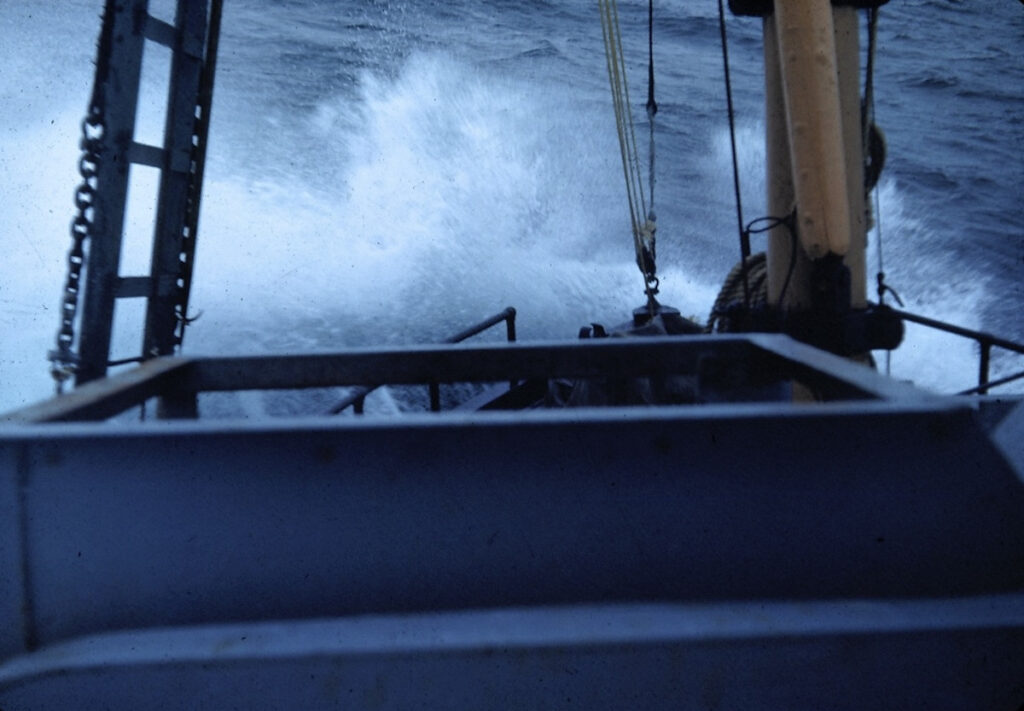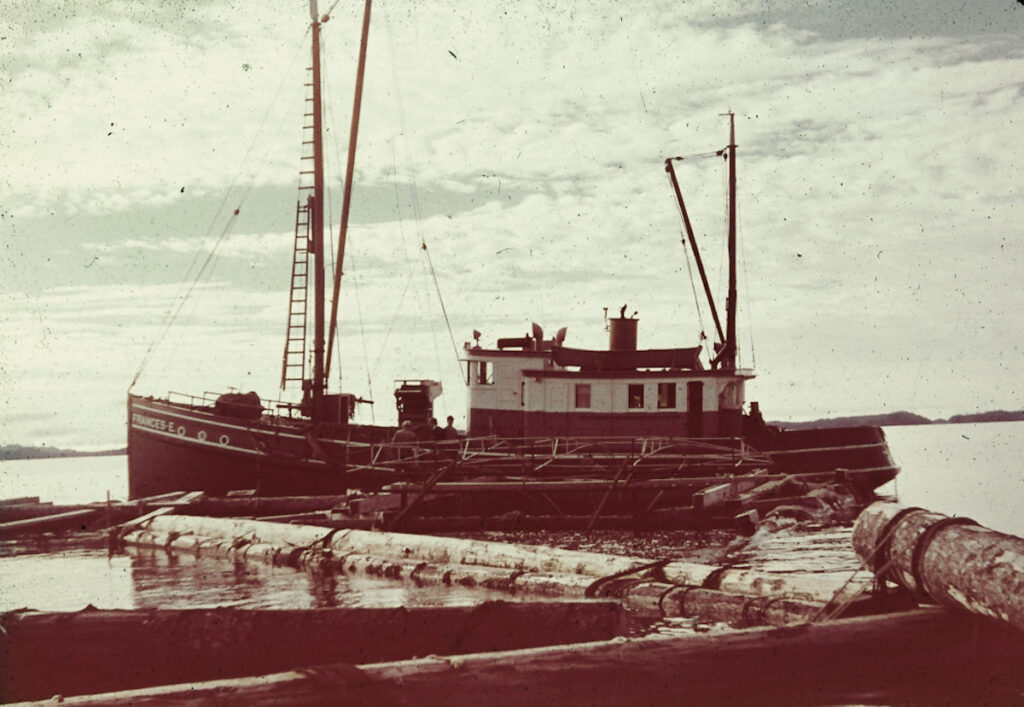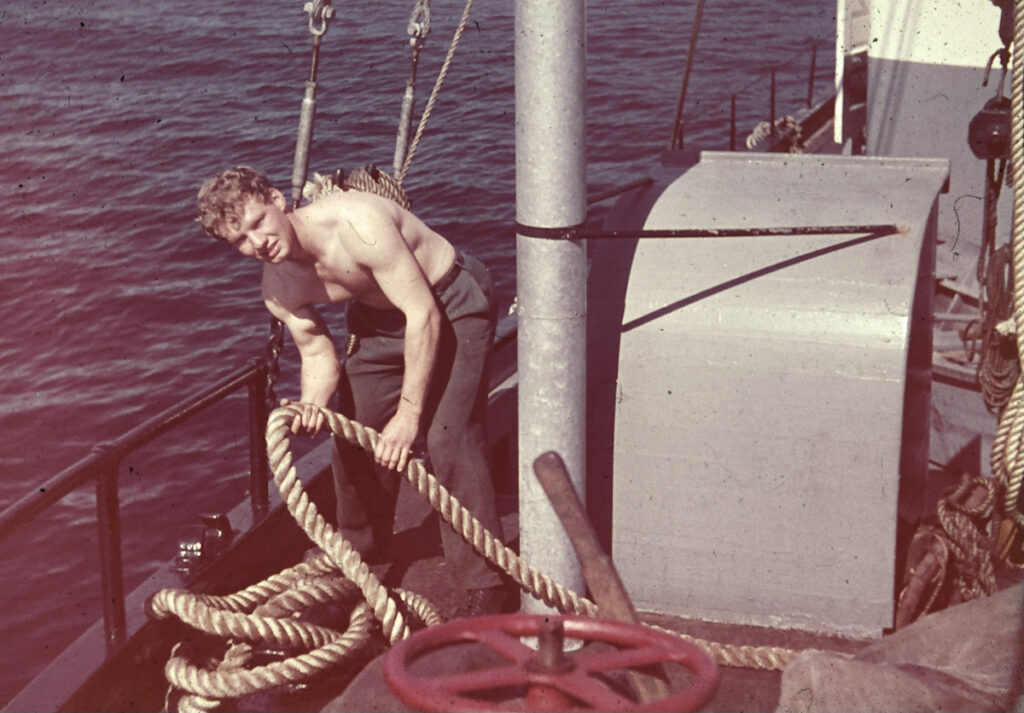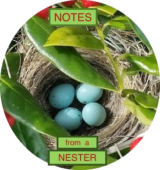You will enjoy my brother Dave’s two stories about his time working out of Waterfall on a cannery tender. The stories are also available in BONDED BY WATER, a memoir Dave published in 2014. Dave was the first of the four Olson boys to work for NAKAT from 1948 until my last season with NAKAT in 1968. Dave’s first story is about a a grounding in a storm and the second story (Coming Post) is a fun story about dog mascot on a tender.
A note from Dave: “I continue to be thankful to the many friends and relations who contributed to the writing and the favorable comments continuing to come my way making me glad I finished BONDED BY WATER. If you are interested in a copy, email Dave Olson at dbolson72@comcast.net and I will respond to your interest in BONDED BY WATER.”
Tim Olson



"CAPTAIN COOL"
The most enjoyable of my seven summers at sea in Southeast Alaska was the 1950 season at Waterfall Cannery. Don Franett, a superintendent for Nakat, asked me to go mate on the tender, Francis E with John (Jack) Hagueness as captain. Jack was a young navy veteran finishing his education in the offseason. He had worked his way up from deckhand to an acting-skipper slot on another Nakat tender the previous season.This was his first full-season assignment. He was a born skipper with a happy crew. So, what made the season memorable?
After the 1950 actual fishing season was over, I experienced a hellish half -minute. All the tenders were busy visiting the traps to pick up watchmen and, following the raising of the anchors holding the traps place, tow them to a protected tide flat for winter storage near the cannery. We were on our way back to the cannery on a dark evening with heavy rain and poor visibility. I was alone in the pilot house as the rest of the crew had a hot pinochle game going in the galley. We were proceeding north in Kaigani Strait between Dall and Long Islands. Approaching Channel Islands the course called for rounding the easterly close with the shore the port side until you could look out from the pilothouse port door and see the narrow gap between the islands, and then resume a northern course to pass safely between the reefs on either side. Bear in mind, those were the days before radar, GPS navigation, or even depth sounders, and there were no lights or other navigation aids in the area. I knew the route and location of the reefs, and Jack knew so his concentration was on the pinochle game
Rounding the island I looked for the view back through the gap just as heavy rain reduced visibility to nothing but gray. Immediately reducing speed to drifting so Jack would know he was needed in the pilothouse would have been the right move. Instead, I guessed the remainder time on course and then turned north. I turned too soon. A few minutes later we slammed into the submerged rock reef. The time was about eight-o-clock.
The bow went up about twenty degrees. The boat lurched forward a few yards, then the engine died, the boat stopped and we listed to port about fifteen degrees. There was an eerie silence. I was shocked. Jack came to the pilothouse door. “I’m sorry,” I moaned.
He quietly responded, “Calm down. Where are we?”
“On the reef we take to starboard after clearing Channel Islands.”
“Okay, you go forward and I’ll go aft for a quick look.”
We both grabbed flashlights. A quick scan revealed no visible leaks. The depth was six feet amidships – not good for a vessel with an eight foot draft. Back in the pilothouse, we checked the tide table. We had grounded on an ebb tide with about two more hours to low water. Best of all, the flood tide calculated rise high enough to float us off by four in the morning. Jack said, ”Just to make sure, Dave, you and Sig (our deckhand) take the flashlights and check the bilges from stem to stern for leaks.
Jack radioed Andy the station (manned 24-7 at the cannery) to calmly report our grounding and location. Don Franett was soon on the mic to tell us he was detaching a tender to our location. Closing he said, “Jack, good luck and call me every thirty minutes to let me know how you are making out.”
Then Jack went back to the galley, asked the cook to make a fresh pot of coffee to replace the pot spilled in the grounding, and talked the card players into resuming the game. With nothing to be gained, hating myself, I divided some of the time between making rounds of the boat continually checking for leaks and shining my flashlight overboard to wonder at the spectral images of tidal life on the reef. Meanwhile, the depth continued to shallow as the tide went out and the port list of the hull increased accordingly to perhaps thirty degrees, with water on the slanted lower port side of the deck. On a subsequent radio call, this development led Jack to say ” Well, major problem now is keeping the cards on the table.” Even I had to laugh. If we had hit that reef at low water, our Francis would probably have been a season-ending wreck instead of an affordable grounding. We had been lucky.
As predicted, when the flood neared high water, we floated free, the engineer started the trusted Atlas diesel, the propeller turned, and we were on our way to the cannery. A diver’s inspection revealed a nasty ten-foot gash in the keel and surface damage to the hull-all repairable at the shipyard in Seattle. I have no idea what Jack wrote in his account of the accident. All he told me was “Dave, don’t worry about it.”
I wish I’d appreciated the wisdom of his advice. Seven months later I realized in a surprise call what he must have done for me in that report. We moved on to finish the season and return to Seattle. If I could locate him, I’d call him today to say thanks, but he disappeared from my life after the 1951 season, probably to pursue a career ashore. In today’s vernacular, he was “Captain Cool.”
To view previous Salmon Summers IV post – click here


